2012 FORD FOCUS shifting
[x] Cancel search: shiftingPage 19 of 406

Trip 1 and 2
Trip odometer — shows the accumulated trip distance. Displayed in
the lower line denoted by a 1: or 2:.
Trip timer — shows the elapsed trip time. This timer will stop when
the vehicle is turned off and will restart when the vehicle is restarted.
Distance to empty — shows the approximate distance the vehicle can
travel before running out of fuel.
Average fuel
economy —
shows the
average
distance
traveled per
unit of fuel
used for a given
trip.Economy Overview— better economy is displayed by
more solid pedals in the flower graphic.
Ford EcoMode
Press OK for
More InfoFord EcoMode Anticipation—
Smooth Driving Saves Fuel
Ford EcoMode Speed
Ford EcoMode Shifting (manual
transmission only) Early Shifting
Saves Fuel
*Ford EcoMode See Manual for
More Tips
Outside air temperature — displays the outside air temperature only if
it not visible in the current view.
Total odometer— shows the vehicle’s total accumulated distance
driven.
*Ford EcoMode operation— this system assists the driver in more
efficient driving by monitoring: shifting, driving speeds and anticipation
of start/stop (traffic conditions). Better economy is displayed by more
solid pedals in the flower graphic; the more efficiently you drive, the
more pedals will be earned. Resetting the average fuel economy value
will reset the EcoMode also.
•Anticipation: adjusting your vehicle’s speed and the distance to other
vehicles without the need for heavy braking or acceleration will
improve fuel economy.
•Speed: higher speeds use more fuel. Reducing your cruising speed on
open roads will improve fuel economy.
•Shifting: early shifting saves fuel and using the proper gear for a given
speed increases fuel economy.
Press and hold OK on the current screen to reset the respective trip,
distance, time and average fuel economy (and EcoMode).
Instrument Cluster
19
2012 Focus(foc)
Owners Guide, 1st Printing
USA(fus)
Page 23 of 406

Trip 1 and 2
Average fuel
economy —
shows the
average distance
traveled per unit
of fuel used for a
given trip.Ford EcoMode
(Better
economy is
displayed by
more solid
pedals in the
flower graphic)Anticipation
Speed
Shifting (manual transmission
only)
OK = More Anticipation
Smooth Driving
Saves Fuel
Speed Current
Score
Early Shifting
Saves Fuel
*Ford EcoMode
See Manual for
More Tips
Outside air temperature — displays the outside air temperature only if
it not visible in the current view.
Total odometer— shows the vehicle’s total accumulated distance
driven.
*Ford EcoMode operation— this system assists the driver in more
efficient driving by monitoring: shifting, driving speeds and anticipation
of start/stop (traffic conditions). Better economy is displayed by more
solid pedals in the flower graphic; the more efficiently you drive, the
more pedals will be earned. Resetting the average fuel economy value
will reset the EcoMode also.
•Anticipation: adjusting your vehicle’s speed and the distance to other
vehicles without the need for heavy braking or acceleration will
improve fuel economy.
•Speed: higher speeds use more fuel. Reducing your cruising speed on
open roads will improve fuel economy.
•Shifting: early shifting saves fuel and using the proper gear for a given
speed increases fuel economy.
Press and hold OK on the current screen to reset the respective trip,
distance, time and average fuel economy (and EcoMode).
Information
MyKey Distance Driven (if MyKey is programmed)
MyKey Information (number of MyKeys and admin keys programmed)
Instrument Cluster
23
2012 Focus(foc)
Owners Guide, 1st Printing
USA(fus)
Page 274 of 406
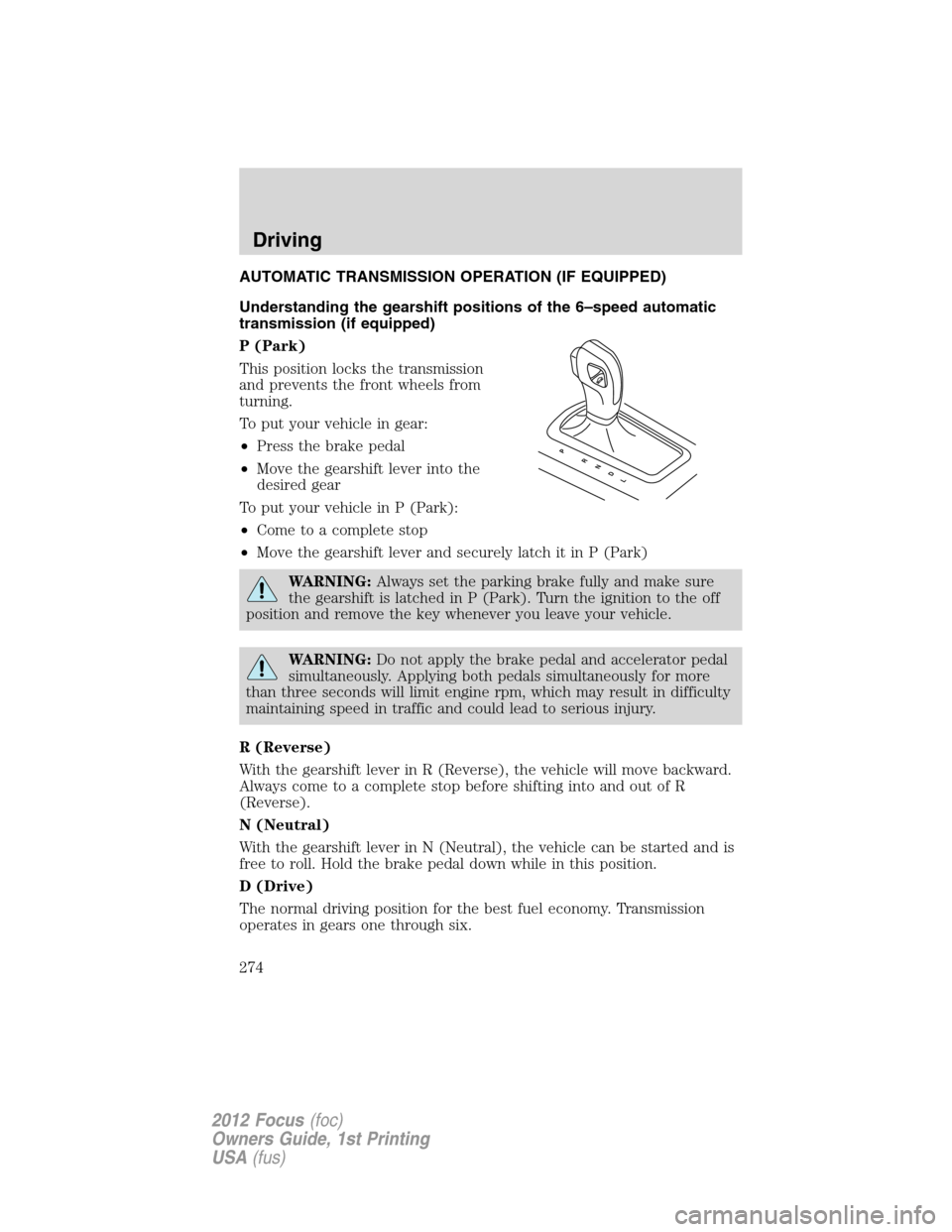
AUTOMATIC TRANSMISSION OPERATION (IF EQUIPPED)
Understanding the gearshift positions of the 6–speed automatic
transmission (if equipped)
P (Park)
This position locks the transmission
and prevents the front wheels from
turning.
To put your vehicle in gear:
•Press the brake pedal
•Move the gearshift lever into the
desired gear
To put your vehicle in P (Park):
•Come to a complete stop
•Move the gearshift lever and securely latch it in P (Park)
WARNING:Always set the parking brake fully and make sure
the gearshift is latched in P (Park). Turn the ignition to the off
position and remove the key whenever you leave your vehicle.
WARNING:Do not apply the brake pedal and accelerator pedal
simultaneously. Applying both pedals simultaneously for more
than three seconds will limit engine rpm, which may result in difficulty
maintaining speed in traffic and could lead to serious injury.
R (Reverse)
With the gearshift lever in R (Reverse), the vehicle will move backward.
Always come to a complete stop before shifting into and out of R
(Reverse).
N (Neutral)
With the gearshift lever in N (Neutral), the vehicle can be started and is
free to roll. Hold the brake pedal down while in this position.
D (Drive)
The normal driving position for the best fuel economy. Transmission
operates in gears one through six.
PRNDL
Driving
274
2012 Focus(foc)
Owners Guide, 1st Printing
USA(fus)
Page 276 of 406
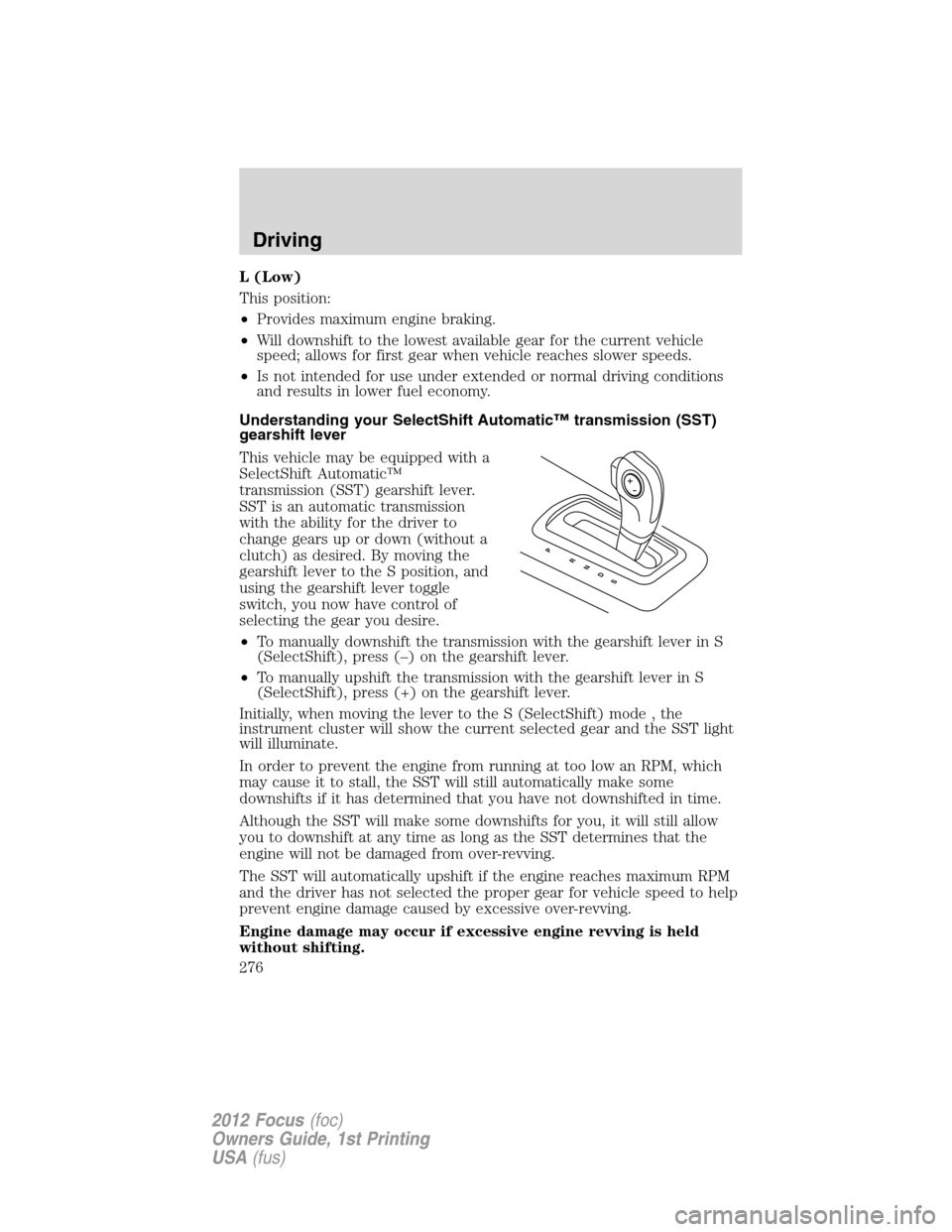
L (Low)
This position:
•Provides maximum engine braking.
•Will downshift to the lowest available gear for the current vehicle
speed; allows for first gear when vehicle reaches slower speeds.
•Is not intended for use under extended or normal driving conditions
and results in lower fuel economy.
Understanding your SelectShift Automatic™ transmission (SST)
gearshift lever
This vehicle may be equipped with a
SelectShift Automatic™
transmission (SST) gearshift lever.
SST is an automatic transmission
with the ability for the driver to
change gears up or down (without a
clutch) as desired. By moving the
gearshift lever to the S position, and
using the gearshift lever toggle
switch, you now have control of
selecting the gear you desire.
•To manually downshift the transmission with the gearshift lever in S
(SelectShift), press (–) on the gearshift lever.
•To manually upshift the transmission with the gearshift lever in S
(SelectShift), press (+) on the gearshift lever.
Initially, when moving the lever to the S (SelectShift) mode , the
instrument cluster will show the current selected gear and the SST light
will illuminate.
In order to prevent the engine from running at too low an RPM, which
may cause it to stall, the SST will still automatically make some
downshifts if it has determined that you have not downshifted in time.
Although the SST will make some downshifts for you, it will still allow
you to downshift at any time as long as the SST determines that the
engine will not be damaged from over-revving.
The SST will automatically upshift if the engine reaches maximum RPM
and the driver has not selected the proper gear for vehicle speed to help
prevent engine damage caused by excessive over-revving.
Engine damage may occur if excessive engine revving is held
without shifting.
PRNDS
Driving
276
2012 Focus(foc)
Owners Guide, 1st Printing
USA(fus)
Page 278 of 406
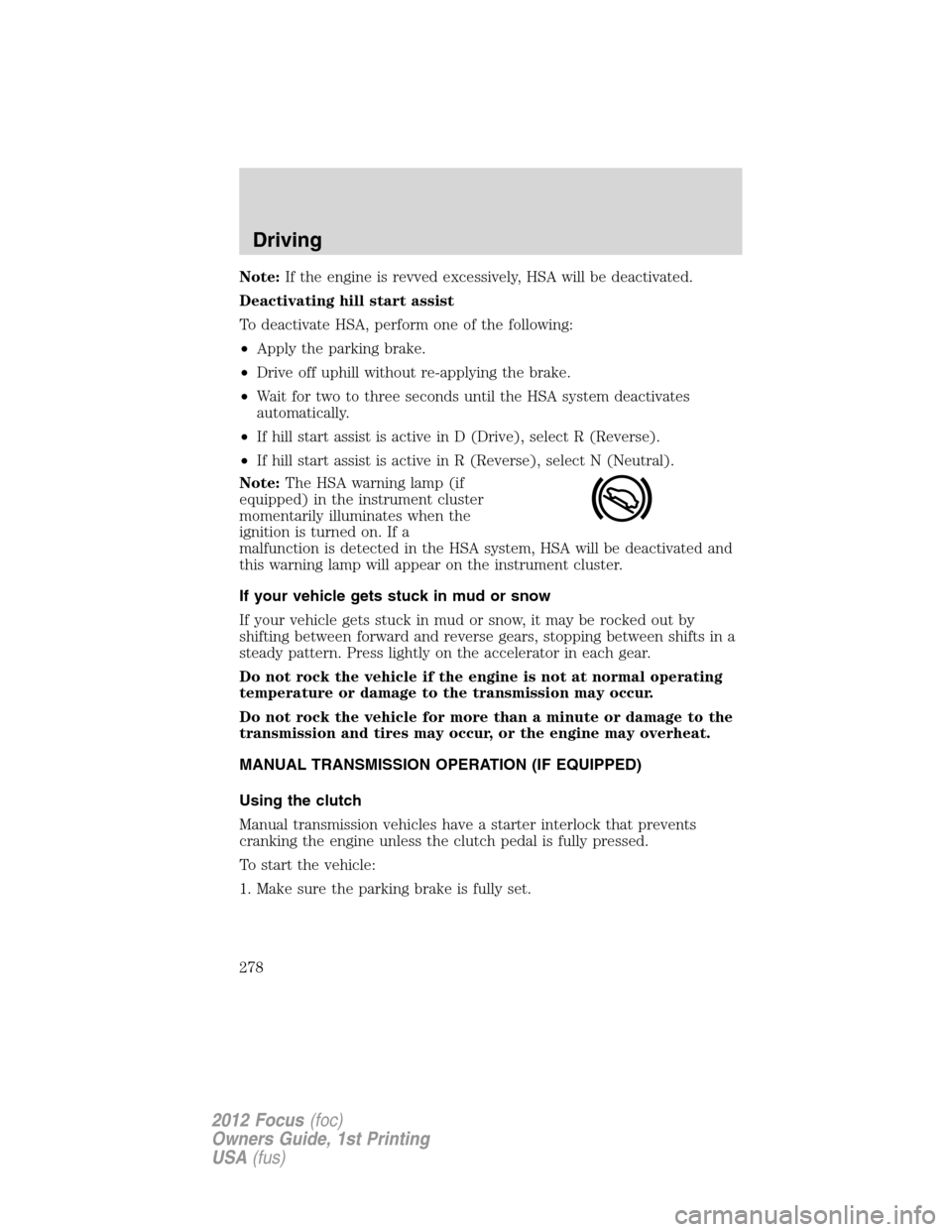
Note:If the engine is revved excessively, HSA will be deactivated.
Deactivating hill start assist
To deactivate HSA, perform one of the following:
•Apply the parking brake.
•Drive off uphill without re-applying the brake.
•Wait for two to three seconds until the HSA system deactivates
automatically.
•If hill start assist is active in D (Drive), select R (Reverse).
•If hill start assist is active in R (Reverse), select N (Neutral).
Note:The HSA warning lamp (if
equipped) in the instrument cluster
momentarily illuminates when the
ignition is turned on. If a
malfunction is detected in the HSA system, HSA will be deactivated and
this warning lamp will appear on the instrument cluster.
If your vehicle gets stuck in mud or snow
If your vehicle gets stuck in mud or snow, it may be rocked out by
shifting between forward and reverse gears, stopping between shifts in a
steady pattern. Press lightly on the accelerator in each gear.
Do not rock the vehicle if the engine is not at normal operating
temperature or damage to the transmission may occur.
Do not rock the vehicle for more than a minute or damage to the
transmission and tires may occur, or the engine may overheat.
MANUAL TRANSMISSION OPERATION (IF EQUIPPED)
Using the clutch
Manual transmission vehicles have a starter interlock that prevents
cranking the engine unless the clutch pedal is fully pressed.
To start the vehicle:
1. Make sure the parking brake is fully set.
Driving
278
2012 Focus(foc)
Owners Guide, 1st Printing
USA(fus)
Page 280 of 406
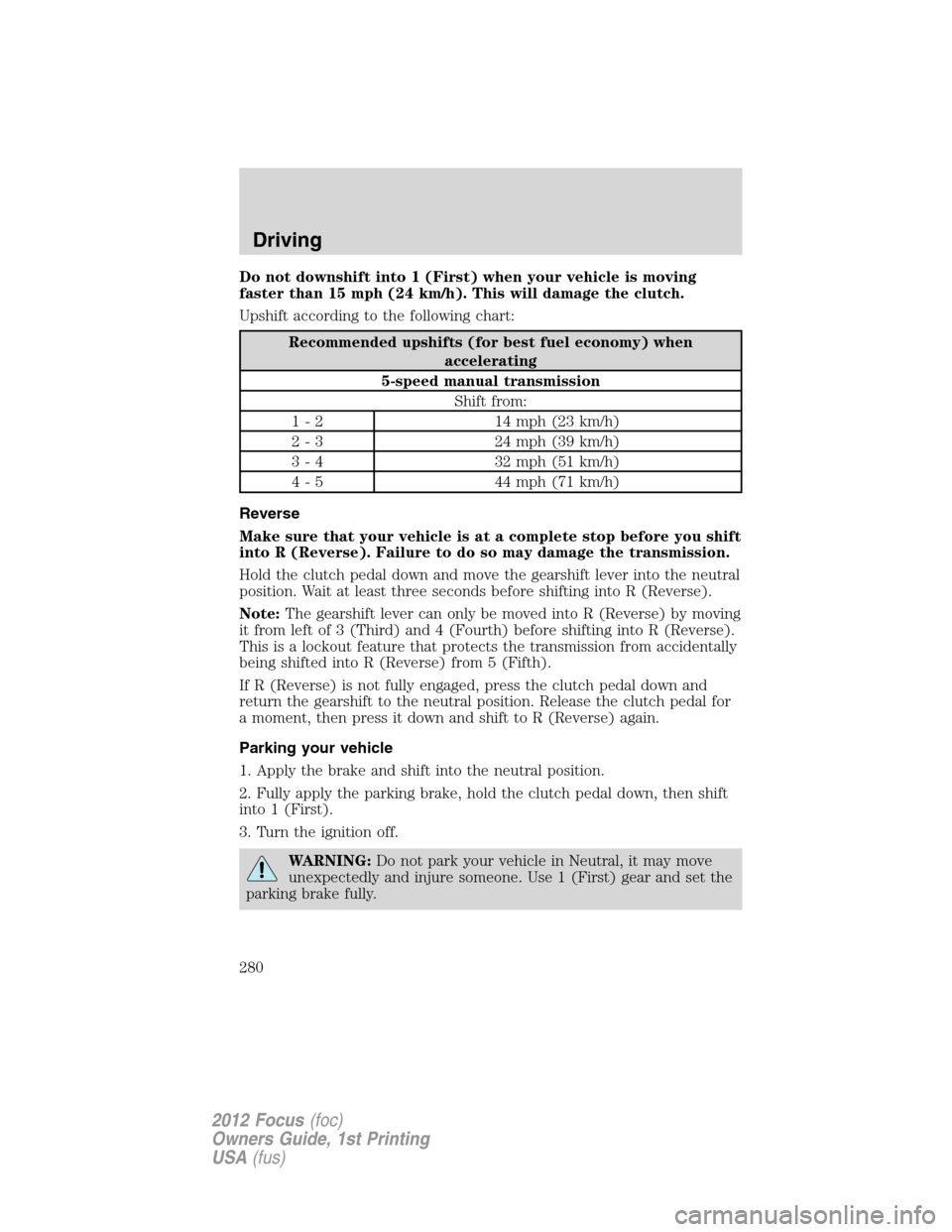
Do not downshift into 1 (First) when your vehicle is moving
faster than 15 mph (24 km/h). This will damage the clutch.
Upshift according to the following chart:
Recommended upshifts (for best fuel economy) when
accelerating
5-speed manual transmission
Shift from:
1 - 2 14 mph (23 km/h)
2 - 3 24 mph (39 km/h)
3 - 4 32 mph (51 km/h)
4 - 5 44 mph (71 km/h)
Reverse
Make sure that your vehicle is at a complete stop before you shift
into R (Reverse). Failure to do so may damage the transmission.
Hold the clutch pedal down and move the gearshift lever into the neutral
position. Wait at least three seconds before shifting into R (Reverse).
Note:The gearshift lever can only be moved into R (Reverse) by moving
it from left of 3 (Third) and 4 (Fourth) before shifting into R (Reverse).
This is a lockout feature that protects the transmission from accidentally
being shifted into R (Reverse) from 5 (Fifth).
If R (Reverse) is not fully engaged, press the clutch pedal down and
return the gearshift to the neutral position. Release the clutch pedal for
a moment, then press it down and shift to R (Reverse) again.
Parking your vehicle
1. Apply the brake and shift into the neutral position.
2. Fully apply the parking brake, hold the clutch pedal down, then shift
into 1 (First).
3. Turn the ignition off.
WARNING:Do not park your vehicle in Neutral, it may move
unexpectedly and injure someone. Use 1 (First) gear and set the
parking brake fully.
Driving
280
2012 Focus(foc)
Owners Guide, 1st Printing
USA(fus)
Page 287 of 406
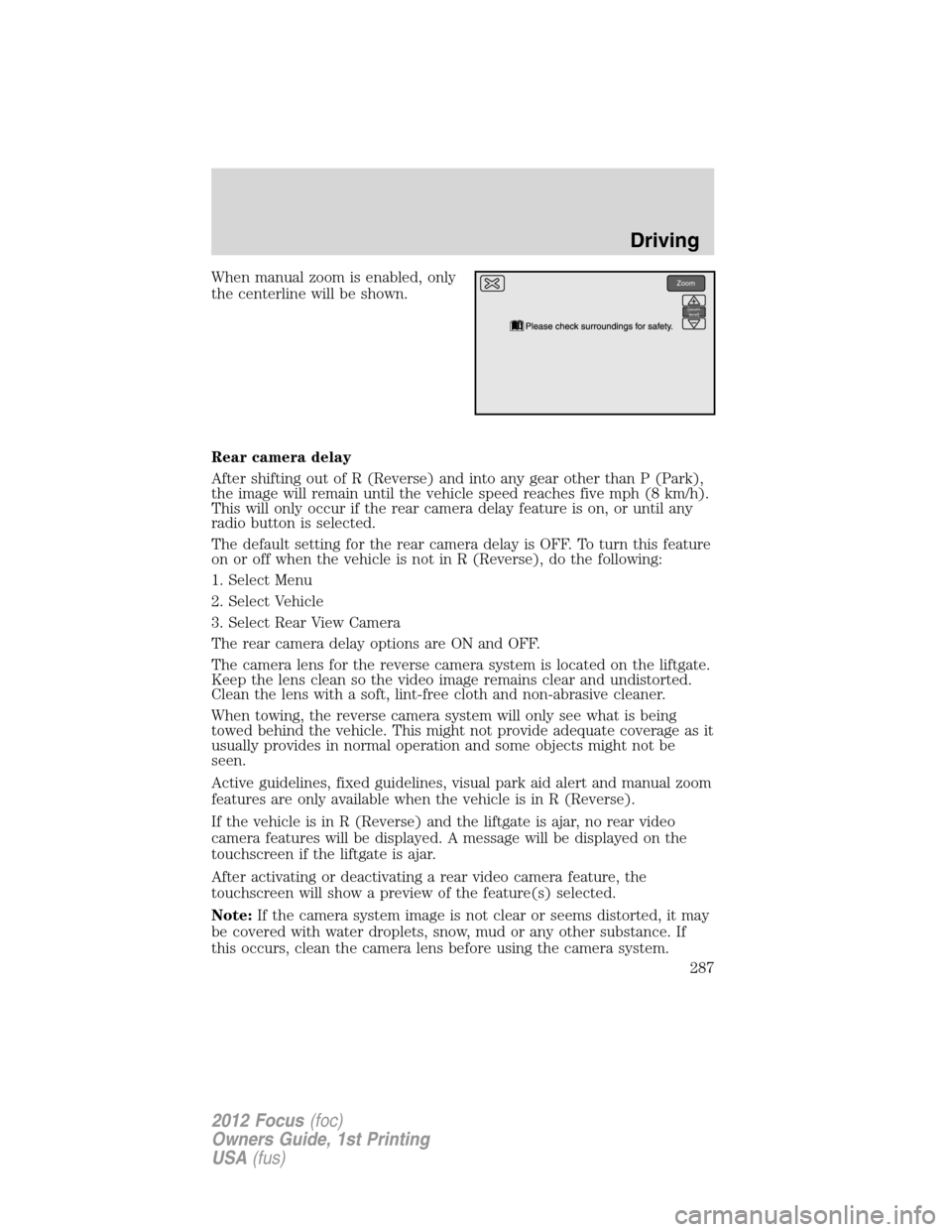
When manual zoom is enabled, only
the centerline will be shown.
Rear camera delay
After shifting out of R (Reverse) and into any gear other than P (Park),
the image will remain until the vehicle speed reaches five mph (8 km/h).
This will only occur if the rear camera delay feature is on, or until any
radio button is selected.
The default setting for the rear camera delay is OFF. To turn this feature
on or off when the vehicle is not in R (Reverse), do the following:
1. Select Menu
2. Select Vehicle
3. Select Rear View Camera
The rear camera delay options are ON and OFF.
The camera lens for the reverse camera system is located on the liftgate.
Keep the lens clean so the video image remains clear and undistorted.
Clean the lens with a soft, lint-free cloth and non-abrasive cleaner.
When towing, the reverse camera system will only see what is being
towed behind the vehicle. This might not provide adequate coverage as it
usually provides in normal operation and some objects might not be
seen.
Active guidelines, fixed guidelines, visual park aid alert and manual zoom
features are only available when the vehicle is in R (Reverse).
If the vehicle is in R (Reverse) and the liftgate is ajar, no rear video
camera features will be displayed. A message will be displayed on the
touchscreen if the liftgate is ajar.
After activating or deactivating a rear video camera feature, the
touchscreen will show a preview of the feature(s) selected.
Note:If the camera system image is not clear or seems distorted, it may
be covered with water droplets, snow, mud or any other substance. If
this occurs, clean the camera lens before using the camera system.Zoom
{zoom
level}
Driving
287
2012 Focus(foc)
Owners Guide, 1st Printing
USA(fus)
Page 360 of 406

Habits
•Smooth, moderate operation can yield up to 10% savings in fuel.
•Steady speeds without stopping will usually give the best fuel
economy.
•Idling for long periods of time (greater than one minute) may waste
fuel.
•Anticipate stopping; slowing down may eliminate the need to stop.
•Sudden or hard accelerations may reduce fuel economy.
•Slow down gradually.
•Driving at reasonable speeds (traveling at 55 mph [88 km/h] uses 15%
less fuel than traveling at 65 mph [105 km/h]).
•Revving the engine before turning it off may reduce fuel economy.
•Using the air conditioner or defroster may reduce fuel economy.
•You may want to turn off the speed control in hilly terrain if
unnecessary shifting between the top gears occurs. Unnecessary
shifting of this type could result in reduced fuel economy.
•Warming up a vehicle on cold mornings is not required and may
reduce fuel economy.
•Resting your foot on the brake pedal while driving may reduce fuel
economy.
•Combine errands and minimize stop-and-go driving.
Maintenance
•Keep tires properly inflated and use only recommended size.
•Operating a vehicle with the wheels out of alignment will reduce fuel
economy.
•Use recommended engine oil. Refer toMaintenance product
specifications and capacitiesin this chapter.
•Perform all regularly scheduled maintenance items. Follow the
recommended maintenance schedule and owner maintenance checks
found inscheduled maintenance information.
Conditions
•Heavily loading a vehicle or towing a trailer may reduce fuel economy
at any speed.
•Carrying unnecessary weight may reduce fuel economy (approximately
1 mpg [0.4 km/L] is lost for every 400 lb [180 kg] of weight carried).
Maintenance and Specifications
360
2012 Focus(foc)
Owners Guide, 1st Printing
USA(fus)